Root-Diggers
(18th and 19th Centuries )
Extracts from Alfred Jacob Miller’s original text, which accompanied his images of Native Americans, are included below for reference. These words, which shaped how Miller’s contemporaries viewed the watercolors, reveal the racism and sexism embedded in 19th-century exploration and colonization of the western part of what is today the United States.
"The wanderers are a branch from the great tribe of Snake Indians, and call themselves Shoshocoes - in contra-distinction probably to Shoshonies, the name of the parent tribe. They are very poor, and subsist mainly on the roots of the earth,- but a mild inoffensive race;- the trappers stated to us that they were not permitted by the war-like tribes to hunt the Buffalo. 'Hark you? Clinker (says the eccentric Matthew Bramble), you are convicted by your own shewing of poverty, sickness, and of being a vagabond, and have not a friend in the wide world.- this is highly reprehensible, and for it you deserve condign and exeplary punishment.' Here is your sentence varlets! - and it is meted out to you by your brother Indians. Thank your stars that you do not live near a civilized community. There would be something worse in store for you! They are somewhat ingenious, and construct bowls and jugs out of a kind of basket work, - they make a serviceable rope also from hemp found in their vicinity." A.J. Miller, extracted from "The West of Alfred Jacob Miller" (1837).
In July 1858 William T. Walters commissioned 200 watercolors at twelve dollars apiece from Baltimore born artist Alfred Jacob Miller. These paintings were each accompanied by a descriptive text, and were delivered in installments over the next twenty-one months and ultimately were bound in three albums. Transcriptions of field-sketches drawn during the 1837 expedition that Miller had undertaken to the annual fur-trader's rendezvous in the Green River Valley (in what is now western Wyoming), these watercolors are a unique record of the closing years of the western fur trade.
Inscription
Provenance
Provenance (from the French provenir, 'to come from/forth') is the chronology of the ownership, custody, or location of a historical object. Learn more about provenance at the Walters.
William T. Walters, Baltimore, 1858-1860, by commission; Henry Walters, Baltimore, 1894, by inheritance; Walters Art Museum, 1931, by bequest.
Exhibitions
| 2006 | Alfred Jacob Miller and the Western Indians. The Walters Art Museum, Baltimore. |
Conservation
| Date | Description | Narrative |
|---|---|---|
| 4/2/1997 | Treatment | mounted; re-housed |
Geographies
USA (Place of Origin)
Measurements
H: 8 7/8 x W: 14 1/8 in. (22.5 x 35.9 cm)
Credit Line
Commissioned by William T. Walters, 1858-1860
Location in Museum
Not on view
Accession Number
In libraries, galleries, museums, and archives, an accession number is a unique identifier assigned to each object in the collection.
In libraries, galleries, museums, and archives, an accession number is a unique identifier assigned to each object in the collection.
37.1940.126







